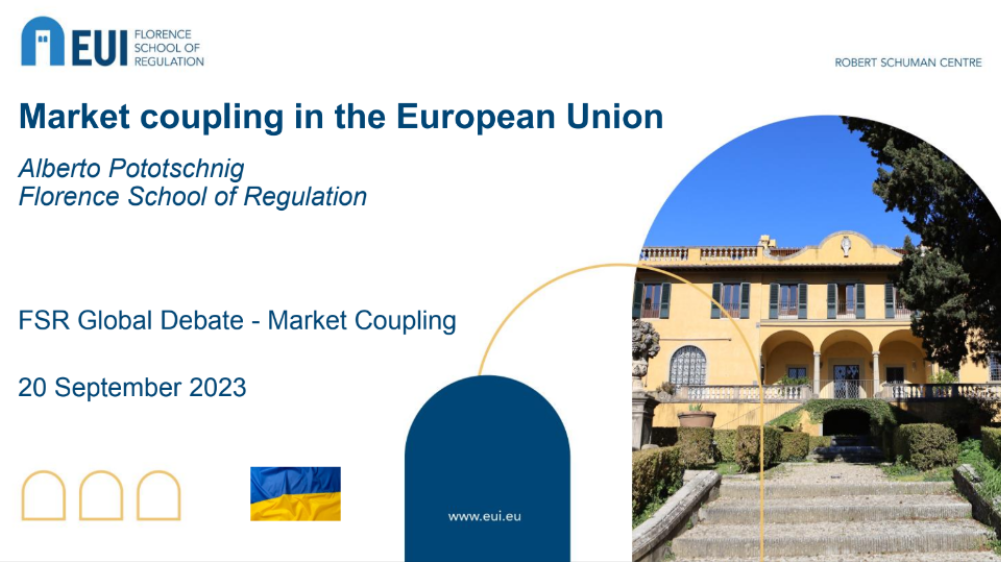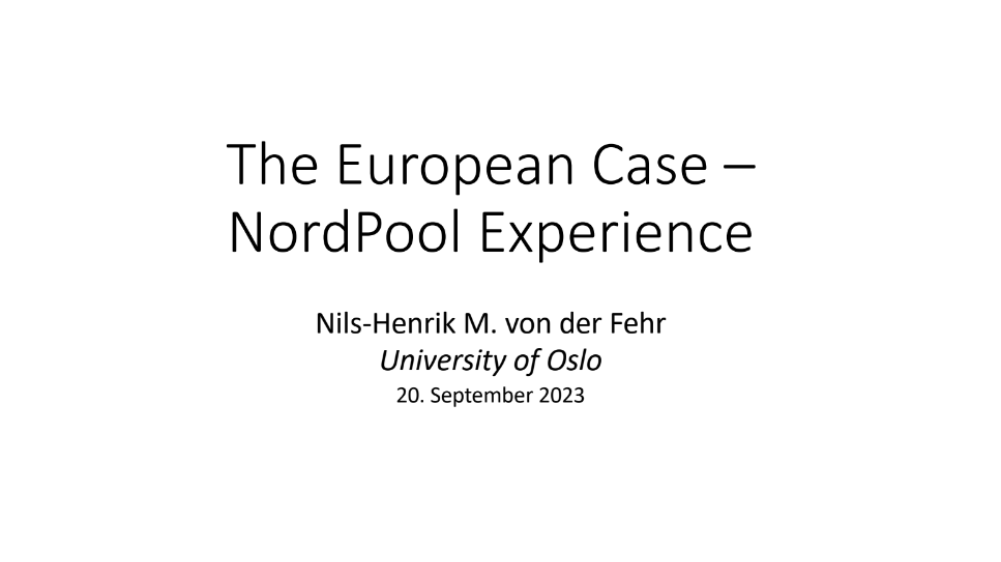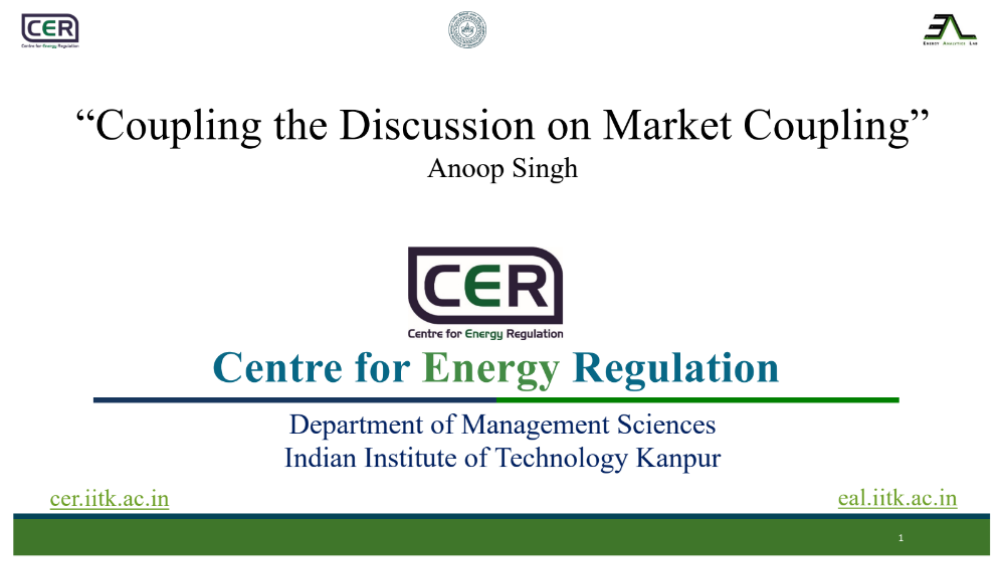Event Highlights
ELECTRICITY MARKET COUPLING IN INDIA

FSR Global
Sep 20, 2023
The first #RegulatoryInsights debate brought together eminent speakers from India and Europe to discuss on the topic of #MarketCoupling. The speakers were PK Pujari, Distinguished Fellow, FSR Global; Alberto Pototschnig, Deputy Director, Florence School of Regulation; Professor Nils-Henrik M von der Fehr, University of Oslo; Professor Anoop Singh, IIT Kanpur and was moderated by Swetha Ravi Kumar, Executive Director, FSR Global.
As the Indian electricity sector undergoes transformations, a fresh idea floated by the federal regulator Central Electricity Regulatory Commission (CERC) in the form of electricity market coupling has entered the power market ecosystem. Market coupling provisions were introduced in (Power Market) Regulations, 2021 (PMR 2021) in 2021, which has been receiving mixed response in its application for India.
Firstly, market coupling would be a misnomer in India since we are a single electricity market, hence, the case of India is unique to deliberate upon w.r.t market coupling as in essence it would be coupling of power exchanges within a single market. At present, there are more than 50 inter-state trading licensees and three power exchanges, namely the Indian Energy Exchange Ltd. (IEX), the Power Exchange of India Ltd. (PXIL) and the Hindustan Power Exchange Ltd. (HPX), operating under the framework of PMR 2021.
In this debate, we examine the exercise of coupling of market exchanges in India with the learnings from the European experience in hindsight.
Market coupling in India: seed for innovation or getting ahead of ourselves?
The main objective of PMR 2021 is to help in creating a comprehensive market structure and enable the transaction, execution, and contracting of various types of products in the power market.
Based on several international experience, there has been evidence that market coupling increases liquidity, innovation, competition and participation by integrating structured marketplaces, which is in line with the aim of PMR 2021 regulation from CERC. The objectives listed by CERC under the PMR 2021 for market coupling must be revisited to answer the central question: (i) discovery of the uniform market clearing price for the Day-Head Market (DAM) or Real-Time Market or any other Market, (ii) optimal use of transmission infrastructure, (iii) maximization of economic surplus after all bids have been accounted for and creating simultaneously buyer-seller surplus.
The issue however battles several questions regarding its application in India. Firstly should market coupling be brought in now considering the monopoly of one power exchange in a market of three exchanges particularly in the day-ahead market and real time market, one of the biggest products in the electricity market. And given that only 6-7% overall trading takes place via power exchanges, is the utilisation of the transmission infrastructure a current problem or one that’s coming due to increased share of renewables?
If market coupling where to be brought in, then how will it be implemented. Would there be a new entity in the form on a market coupling operator (MCO), if yes then who will execute this role, one of the power exchanges in a rotational basis, the system operator or a third party entirely? With respect to market trading algorithm, would we use and harmonise one of the existing propriety software from within the power exchanges of will a new one be developed? Importantly, will market coupling or in the case of India power exchange coupling bring in more innovation given the reduced role of power exchanges.
Market coupling lessons from Europe
With Europe, coupling was across different jurisdictions to allocate and use the interconnection capacity efficiently. Europe developed itself as a regional market, differing from jurisdictional markets. They have successfully integrated an European target model to show how different power exchanges over different time frames have been working since 15 years to create an internal market. Such organised market places are beacons for healthy competition by pooling the liquidity thereby increasing the efficiency of trading.
The key is to resolve the trade-off between enabling innovation and products getting toppled due to market monopoly. Harmonizing rules are needed to settle this. European experience proves that it is necessary to have political support, identify one time implementation costs, lay out clearly the benefits of such an exercise, ensure stakeholder involvement, and be clear with the governance structure and implementation from the beginning.
European Power Exchanges – Monopoly or Competing?
Even within Europe, we see different kinds of experiences with respect to their power exchanges. In some cases we have a monopoly power exchange such as the NordPool operating in multiple countries single geographic jurisdiction and in some cases we see different power exchanges competing within the same geographic jurisdiction. Gradually over time, one power exchange tends to dominate the geography in terms of its market share in trading volumes. However, in the case of Europe, the volumes traded on the power exchange is larger than the share of bilateral or over the counter (OTC) contracts and hence the wholesale spot market has more liquidity.
Looking at the case of the monopoly example of the NordPool, its success has been attributed to multiple factors. Firstly the organised market place was driven by market participants in Norway directly without government intervention in 1991. And an early acknowledgement by neighbouring countries such as Sweden, Finland, Denmark coming in with their varied generation mix to pool markets due to de-regulation has been a major contributor. After its success in the Scandinavian region, NordPool today has expanded its operations by adding countries, particularly the Baltics, and accessing varied regions with other significant power pools or power exchanges, such as France, Germany, Belgium, Austria, and the Netherlands.
Despite it being a completely integrated market where transmission capacities are being utilized to their full extent, there are considerable price differences between the different regions depending on the demand and supply. The market is very liquid with most of the physical trade going through spot markets.
However, integrating so many markets necessitates the involvement of multiple stakeholders making the whole process an intense regulatory challenge. Issues like price zone granularity and real-time trading make integration challenging. Despite regional and national differences, the North Pool and Europe have successfully integrated.
Things to consider in the case of India
Before rolling out market coupling in India, it’s important to answer a few questions with some clarity. Is market coupling being introduced to enable competition, given the large share of one of the power exchanges? Why is there low liquidity on some platforms or across some of the market products, in which case should coupling be first tried out in lesser liquid products first? Is there lack of information transmission across the different power exchanges? If the role of power exchanges is reduced to bid collecting agency, will there be scope for innovation and investment in new technology? Will new market entrants come in and how to address risk of entry and exit of non-serious players? What will be the role of a market coupling operator, who will execute this and what is the revenue model for the MCO? How will dispute resolution take place between the multiple parties? Should India try alternative solutions first such as power market derivatives to help dissipate risks arising out of divergent market clearing price.
In the case of India, given that many questions are still to be answered wr.t market coupling, a thorough analysis of the same needs to be done. The time to implement may not yet be right, but one that can be enabled in the future once some of the more structural and fundamental issues are ironed out in the Indian power markets.
Presentations



